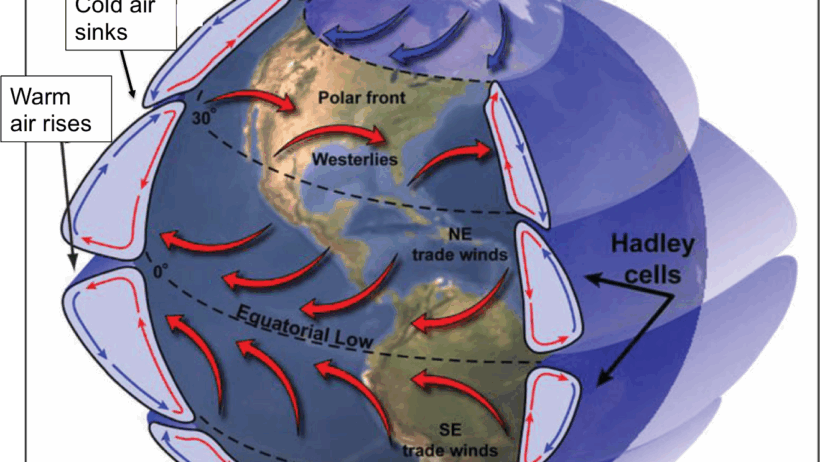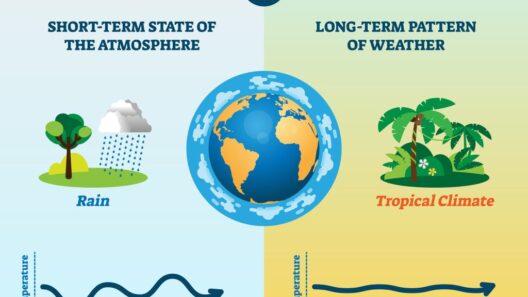The atmosphere, a vast and intricate web, cradles our planet, directing the flow of wind currents like an invisible conductor guiding a symphony of climatic conditions. These wind currents play a pivotal role in regulating temperatures, distributing heat across the Earth’s surface, and shaping weather patterns. Understanding how these ebbs and flows of air impact our climate is paramount in comprehending the intricate tapestry of our planet’s ecosystems.
To appreciate the significance of wind currents, one must envision the Earth as a living organism. Just as the heart pumps blood to sustain life, wind currents circulate energy, acting as the arteries of our planet’s climate system. This circulation of air results from the unequal heating of the Earth’s surface by the sun. Areas near the equator receive abundant solar energy, leading to warmer conditions, while polar regions bask in much less. This temperature disparity creates a driving force that moves air from high-pressure zones to low-pressure zones, manifesting as wind.
As wind circles the globe, it interacts with various geographical features—mountains, oceans, and forests—transforming into a complex system of regional climates. The trade winds, for example, are persistent easterly winds found in the tropics, playing a crucial role in weather patterns and ocean currents. Their influence extends well beyond mere breezes; they carry moisture from the ocean, setting off chain reactions leading to rainfall in distant lands. This allocation of precipitation influences not only agricultural practices but also the survival of ecosystems that rely on specific climatic conditions.
Moreover, wind currents are integrally tied to oceanic movements, creating what can be described as a dance of currents that governs both marine and terrestrial climates. The ocean is often referred to as the planet’s climate regulator, absorbing heat from the sun and redistributing it through currents. The Gulf Stream, a warm Atlantic current, is an apt illustration of this phenomenon. Originating in the Gulf of Mexico, it transports warm water northward, dramatically influencing the climate of Western Europe. Without this current, vast swathes of Europe would experience a dramatically harsher climate, akin to that of Canada, despite their similar latitudinal positions. The tale of the Gulf Stream encapsulates the symbiotic relationship between wind and water, emphasizing the intricate balance that sustains our climate.
On a broader scale, wind currents influence the phenomenon of El Niño and La Niña. These alterations in oceanic and atmospheric conditions exemplify the delicate balance of our climate system. During an El Niño event, trade winds weaken, allowing warmer waters to accumulate in the central and eastern Pacific. This shift not only alters ocean temperatures but reverberates through the atmosphere, causing droughts, floods, and shifts in agricultural productivity across continents. Similarly, La Niña, characterized by stronger than usual trade winds, can lead to its own set of climatic anomalies. Such oscillations demonstrate that our climate is not static but rather a dynamic and ever-evolving system, susceptible to the finest of changes in wind patterns.
The influence of wind currents extends to the concept of climate zones. The interactions between different air masses can create distinct climatic conditions, like the arid deserts or lush rainforests that adorn our planet. For instance, the presence of the Himalayas disrupts prevailing winds, leading to the formation of the monsoon system in South Asia, where dry seasons yield to torrential rains, nurturing one of the most biodiverse regions on Earth. This example highlights not only the role of wind as a climate influencer but also its broader implications for biodiversity and the resilience of ecosystems.
Furthermore, exploring the local effects of wind currents enhances our appreciation of their climatic significance. Microclimates can emerge from the interplay of elevation, proximity to bodies of water, and wind direction. Coastal regions often experience milder climates due to the moderating influence of ocean breezes, while inland areas may face stark temperature fluctuations. Understanding these microclimates is invaluable for agriculture, urban planning, and resource management, as they facilitate adaptations to climate variability.
Yet, as the climate crisis escalates, the intrigue of wind currents takes on a new dimension. The impacts of climate change are altering established wind patterns, raising concerns about the ramifications for our climate system. The potential for stronger and more erratic storms, shifts in precipitation patterns, and disruptions to ocean currents could reverberate through the global food supply, biodiversity conservation, and even community livelihoods. These changes beckon a call to action, necessitating that society acknowledges the vital role of wind currents in maintaining the delicate equilibrium of our climate.
In conclusion, the currents of wind are artful, invisible streams that weave through the fabric of Earth’s climate. From global weather patterns to local microclimates, these currents play an essential role in orchestrating the phenomena that shape our environment. As stewards of our planet, understanding the influence of wind currents on climate underscores the importance of sustaining this delicate balance. The future of our climate, our ecosystems, and ultimately our survival hinges on recognizing and preserving the intimate relationship between wind, water, and life on Earth.




